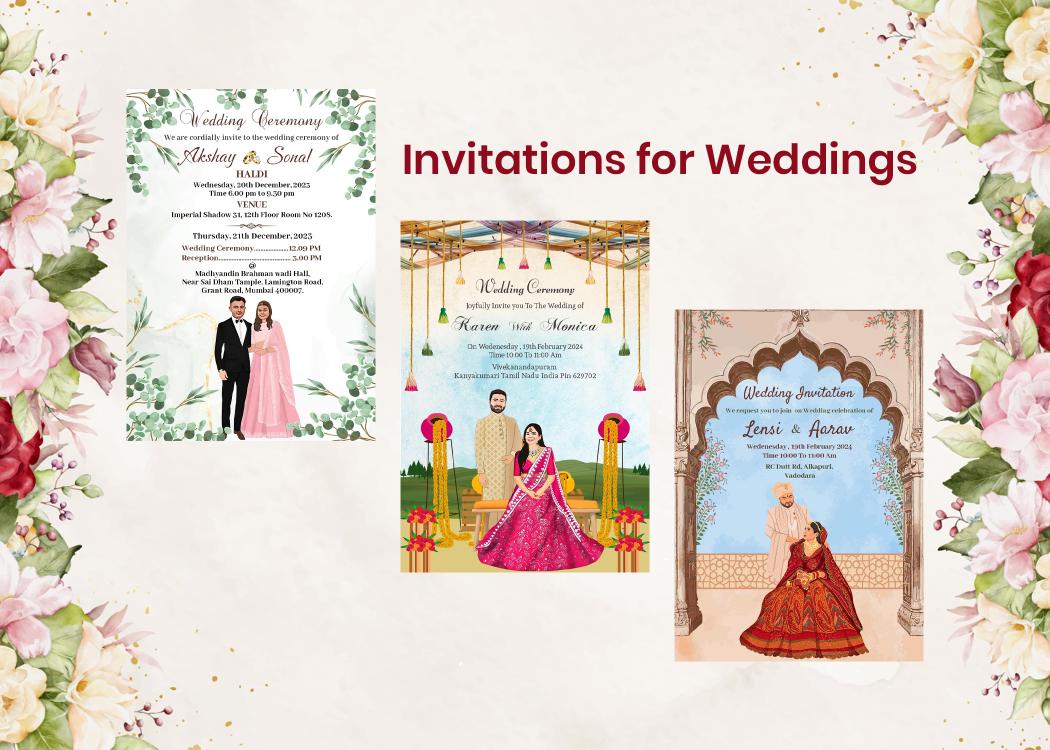Introduction to Wedding Invitations
A invitation message for marriage is the first glimpse your guests will have of your special day. It sets the tone for the entire event, reflecting the theme, formality, and personality of the couple. Crafting a perfect wedding invitation requires attention to detail, creativity, and a touch of elegance. In this comprehensive guide, we will explore the elements that make an invitation truly exceptional, from wording to design.
Choosing the Right Wording for Your Invitation
Formal Wedding Invitation Wording
For a traditional wedding, formal wording is often preferred. This style exudes sophistication and respects the formalities of a classic wedding.
Examples:
- “Mr. and Mrs. John Smith request the honor of your presence at the marriage of their daughter, Emily Jane, to Mr. James Alexander.”
- “Together with their families, Sarah Elizabeth and Michael Andrew invite you to celebrate their union.”
Informal Wedding Invitation Wording
For a more relaxed and casual celebration, informal wording can convey a sense of warmth and intimacy.
Examples:
- “You’re invited to celebrate the wedding of Emily and James!”
- “Join us for the wedding of Sarah and Michael!”
Key Elements of a Wedding Invitation
Names of the Hosts
The names of the hosts, often the parents of the bride or the couple themselves, should be prominently featured at the top of the invitation. This acknowledges their role in hosting the event and sets a respectful tone.
Request Line
The request line is a formal invitation to your guests. Phrases like “request the honor of your presence” or “cordially invite you to” are traditional choices.
Names of the Couple
The names of the bride and groom are the focal point of the invitation. Ensure they stand out by using a larger font or a different style.
Date and Time
Clearly state the date and time of the ceremony. Use full names for days and months to maintain a formal tone.
Example:
- “Saturday, the fifth of October, two thousand and twenty-four, at five o’clock in the evening.”
Venue Details
Include the full address of the ceremony and reception venues. If the reception is at a different location, provide a separate line or card with those details.
Dress Code
Indicating the dress code helps guests prepare appropriately. Common dress codes include “Black Tie,” “Cocktail Attire,” or “Casual.”
RSVP Information
Provide clear instructions for RSVP, including the deadline and contact information. Consider adding a response card for convenience.
Designing Your Wedding Invitation
Theme and Style
The design of your invitation should reflect the overall theme and style of your wedding. Whether it’s a rustic barn wedding or a glamorous black-tie event, the invitation sets the stage.
Themes:
- Rustic: Utilize natural textures like kraft paper, twine, and floral motifs.
- Elegant: Choose luxurious materials such as vellum, silk ribbons, and gold foil accents.
- Modern: Opt for clean lines, minimalistic designs, and bold typography.
Color Scheme
Select a color scheme that complements your wedding colors. Consistency in color helps create a cohesive look across all wedding stationery.
Typography
Typography plays a crucial role in the overall aesthetic. Combine different fonts to highlight important details. Script fonts are often used for names, while serif or sans-serif fonts work well for the body text.
Embellishments
Consider adding special touches like embossing, foil stamping, or laser-cut designs to make your invitation stand out.
Printing Methods
Choose a printing method that aligns with your budget and desired look. Options include:
- Digital Printing: Cost-effective and versatile.
- Letterpress: Creates a luxurious, tactile impression.
- Engraving: Offers a high-end, timeless finish.
Including Additional Information
Directions and Maps
Provide directions or a map to ensure guests can easily find the venue. This is especially important for destination weddings or locations that are difficult to find.
Accommodation Details
If you have reserved blocks of rooms at local hotels, include this information to assist out-of-town guests in finding convenient accommodations.
Registry Information
While it is traditionally considered improper to include registry details on the main invitation, you can include this information on a separate card or your wedding website.
Wedding Website
A wedding website can serve as a central hub for all wedding-related information. Include the URL on your invitation for guests to access details about the schedule, dress code, and registry.
Tips for Sending Out Your Invitations
Timing
Send out your invitations 6-8 weeks before the wedding. For destination weddings, send them 3-4 months in advance to give guests ample time to make travel arrangements.
Envelope Addressing
Addressing the envelopes by hand adds a personal touch. Consider hiring a calligrapher for a polished and elegant look. If that’s not feasible, high-quality printed labels are a suitable alternative.
Postage
Weigh a complete wedding invite messages suite at the post office to determine the correct postage. Invitations with multiple cards or embellishments may require additional postage.
Conclusion
Crafting the perfect wedding invitation involves a blend of thoughtful wording, elegant design, and meticulous attention to detail. By following these guidelines, you can create an invitation that not only informs your guests but also excites them about your upcoming celebration. Remember, your wedding invitation is a reflection of your unique love story, so let it shine with personality and charm.

